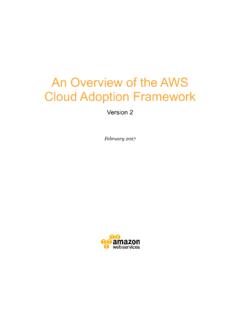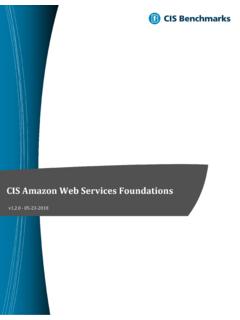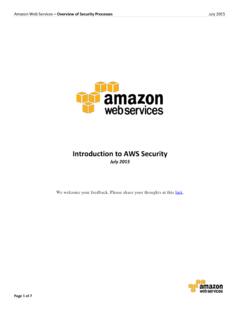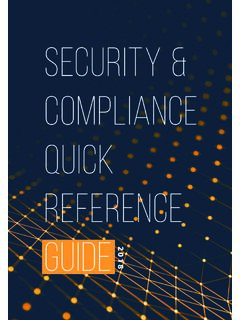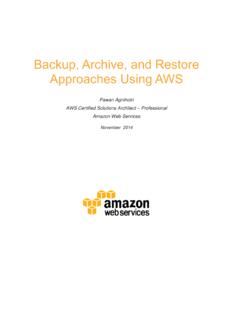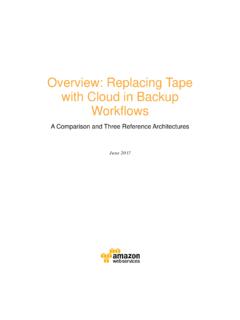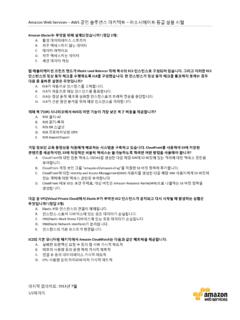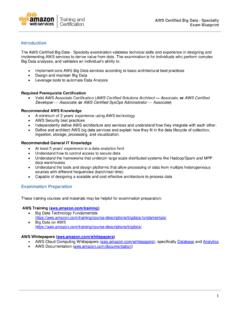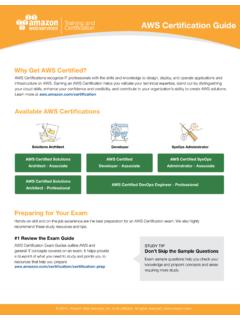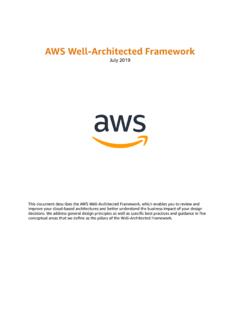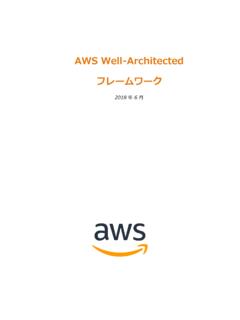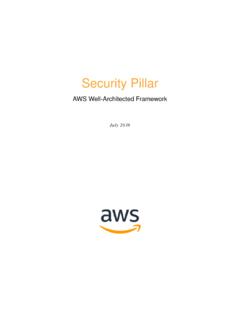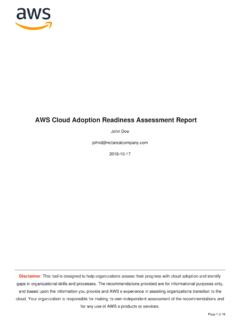Transcription of Cost Optimization with AWS - d0.awsstatic.com
1 cost Optimization with AWS. Architecture, Tools, and Best Practices February 2016. Amazon Web Services cost Optimization with AWS January 2016. 2016, Amazon Web Services, Inc. or its affiliates. All rights reserved. Notices This document is provided for informational purposes only. It represents AWS's current product offerings and practices as of the date of issue of this document, which are subject to change without notice. Customers are responsible for making their own independent assessment of the information in this document and any use of AWS's products or services, each of which is provided as is . without warranty of any kind, whether express or implied. This document does not create any warranties, representations, contractual commitments, conditions or assurances from AWS, its affiliates, suppliers or licensors. The responsibilities and liabilities of AWS to its customers are controlled by AWS agreements, and this document is not part of, nor does it modify, any agreement between AWS.
2 And its customers. Page 2 of 22. Amazon Web Services cost Optimization with AWS January 2016. Contents Abstract 3. Introduction 4. cost Optimization 4. Design Principles 5. Matching Supply and Demand 6. Compute 6. Storage 10. Application Services 12. cost -Effective Resources 17. A Granular Approach 17. Expenditure Awareness 18. AWS Price List API 19. Detailed Billing Reports 19. Optimizing Over Time 20. Conclusion 20. Contributors 20. Appendix: cost -Effective Storage Example 21. Further Reading 22. Abstract The focus of this paper is the cost Optimization pillar of the Well-Architected Framework. It provides guidance to help customers apply best practices in the design, delivery, and maintenance of AWS environments. Page 3 of 22. Amazon Web Services cost Optimization with AWS January 2016. Introduction At AWS, we understand the value of educating our customers about architectural best practices for designing reliable, secure, efficient, and cost -effective systems in the cloud.
3 As part of this effort, we developed the AWS Well-Architected Framework, which helps you understand the pros and cons of decisions you make while building systems on AWS. We believe well-architected systems greatly increase the likelihood of business success. The framework is based on four pillars: Security Reliability Performance Efficiency cost Optimization The cost Optimization pillar helps you avoid or eliminate unnecessary costs or suboptimal resources and use the savings on differentiated benefits for your business. A cost -optimized system allows you to pay the best price possible while still achieving your business objectives and meeting or exceeding requirements for the other pillars in the framework. This paper will provide in-depth, best- practice guidance for selecting the appropriate architecture and maximizing your AWS resources as efficiently as possible. cost Optimization Business problems can be operational in nature (having support teams on call), wasteful (overprovisioning hardware resources), vulnerable to failure (tightly coupled deployments), and expensive (running a data center, employing security staff, and so on).
4 AWS offers solutions to these problems, but it's important to understand and implement services with cost Optimization in mind. At AWS, we think about four areas of cost Optimization : Matched supply and demand cost -effective resources Page 4 of 22. Amazon Web Services cost Optimization with AWS January 2016. Expenditure awareness Optimizing over time Along with improved security or speed to market, cost and return on investment (ROI) are often determining factors in a purchasing decision. AWS has several tools, such as AWS Trusted Advisor, detailed billing reports, and the Total cost of Ownership Calculator, to help you understand your bill, calculate your cost of ownership, and identify areas for improvement. There are also AWS case studies and references that can serve as quantitative support to aid your decision-making process. Design Principles Keep these design principles in mind as we discuss best practices in the four areas of cost Optimization : Move from a forecast-procurement model to a consumption model: Instead of investing heavily in data centers and servers based on historical data or pro-forma forecasts, pay only for the computing resources you consume and increase or decrease usage depending on need, not elaborate forecasting.
5 For example, development and test environments are typically only used for eight hours a day during the work week. You can stop these resources when they are not in use for a potential cost savings of 75% (40 hours versus 168 hours). Benefit from economies of scale: Hundreds of thousands of customers are aggregated in the AWS cloud, which translates into lower pay-as-you-go prices. Stop spending money on data center operations: Cloud computing vendors do the heavy lifting of racking, stacking, and powering servers, so you can focus on your customers and core business rather than on IT. infrastructure. Transparently attribute expenditure: The cloud makes it easier to identify the cost of a system and attribute IT costs to individual business owners. This helps measure ROI and gives those owners an incentive to optimize their resources and reduce costs. Use managed services to reduce cost of ownership: In the cloud, managed services remove the operational burden of maintaining servers for tasks like sending email or managing databases.
6 And because managed Page 5 of 22. Amazon Web Services cost Optimization with AWS January 2016. services operate at cloud scale, they can offer a lower cost per transaction or service. Continuously reevaluate design choices: Unlike traditional IT. infrastructure approaches where you are required to make large capital investments in hardware and software, AWS offers pay-as-you-go pricing for most of its services. This means you are not bound by decisions made at a design level at the beginning of a project's lifecycle. This reduces the risks of overprovisioning or not being able to meet unexpected demand. You can continually reevaluate your design decisions. You can also explore the use of new AWS products to see if they lead to even greater efficiencies. Matching Supply and Demand Unlike traditional IT infrastructure models, AWS is, by its very nature, elastic and on-demand. AWS provides mechanisms to programmatically scale up and down, as needed, or to implement lifecycle rules that archive or expire storage objects automatically.
7 Consider these features and services to help you achieve a cost -optimized architecture. Compute In the AWS ecosystem, compute begins with Amazon Elastic Compute Cloud (Amazon EC2). At its most basic level, EC2 is virtual machines in the cloud. Amazon EC2 has evolved since 2006 and, as shown in the following diagram, led to other services, such as Auto Scaling and Amazon EC2 Container Service (for increased efficiency), Elastic Load Balancing (for resilience), and AWS Lambda (for server-less computing). Amazon EC2. Page 6 of 22. Amazon Web Services cost Optimization with AWS January 2016. cost Optimization can only be successful if you are able to match the requirements of your application or workload with the most appropriate instance type. The Amazon EC2 instance types and sizes1 offer varying combinations of CPU, memory, storage, and network capacity to give you the flexibility to choose the right mix of resources for your application. For example, C4 instances are suited to workloads that require heavy computational resources.
8 M4 instances are a multi-role instance type. G2 instances are aimed at workloads that require dedicated graphic processors. Choosing the right instance type will help you optimize performance in a cost -effective way. After you understand your workload requirements, consider taking advantage of Reserved Instances and Spot Instances, which can result in a 30% or up to 90%. reduction, respectively, in your EC2 spending. Benchmarking AWS recommends you select an instance type from the instance family that most closely matches your workload, and then start a period of benchmarking. Because you can change the instance type, it's possible to perform benchmarking against each type. You can also do this when AWS releases new instance types. Reserved Instances After you have settled on an instance type, you have the option of purchasing a Reserved Instance. This is an upfront commitment to purchase capacity in a particular AWS region, which will dramatically reduce your running costs.
9 A Reserved Instance is a billing construct; it ensures you have capacity available in the Availability Zones2 (AZ) you have selected and purchased for that instance type, and will significantly reduce your hourly rate. Besides treating a Reserved Instance as a 24x7 resource, it is also possible for you to combine a Reserved Instance if your workload is time-dependent. For example, let's assume you have a Reserved Instance for a multi-purpose instance type like an You only need to run this instance during office 1 Each instance type has a different running cost (per hour). Typically, the larger the instance type, the more expensive. 2 #concepts-regions-availability-zones Page 7 of 22. Amazon Web Services cost Optimization with AWS January 2016. hours for a total of nine hours (8:00 :00 ). However, you have another workload in the same Availability Zone that can use the same instance type and be run after office hours (5:00 ). You could select the same instance type ( ) and start the evening workload on that instance after the daytime instance has shut down.
10 After the first instance is shut down, the Reserved Instance hourly rate will apply to the after-hours instance, thus maximizing your overall cost efficiency. It's important to continually reevaluate your instance selection, because workloads and instance types will change over time. Reserved Instances are currently offered as one- or three-year commitments3, and your requirements may change before the Reserved Instance commitment expires. If this should happen, you could use EC2 Container Service (Amazon ECS) to increase instance usage, or you could sell your Reserved Instances in the AWS Reserved Instance Marketplace. Auto Scaling Auto Scaling allows you to scale your Amazon EC2 capacity up or down automatically according to conditions you define. For example, traditional IT. deployments require you to determine your hardware requirements based on peak usage. If your compute resources are determined by the highest predictable period of load and do not allow you to scale down, you are wasting compute resources when the load is at its lowest.
